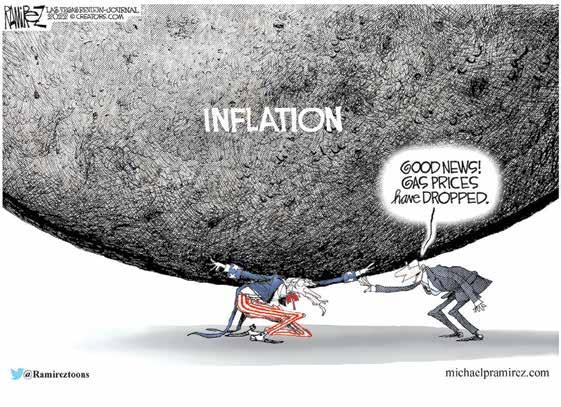
4 minute read
The U.N. is Getting Ukraine Surprisingly Right by David Ignatius
Political Crossfire The U.N. is Getting Ukraine Surprisingly Right
By David Ignatius
As President Biden and other world leaders gather in New York this week to address the U.N. General Assembly, there’s an unusual twist: The United Nations, so often derided as a useless forum for debate rather than action, is working aggressively to contain the damage from Russia’s invasion of Ukraine.
This is a diplomatic version of “man bites dog.” “I would have predicted that the U.N. would act as ineffectively as the League of Nations in the 1930s, but the opposite has happened,” says Jeffrey Feltman, a former State Department official who served as the United Nations’ under-secretary-general for political affairs. He told me that in the Ukraine crisis, the United Nations “has shown more coherence than I’ve ever seen from the organization in my career.”
The United Nations can’t stop this grinding war because of Russia’s veto power in the Security Council. But it has worked to address some of the side effects, such as the Russian blockade of Ukrainian grain exports, which has exacerbated the global food shortage, and Russian threats to the big Ukrainian nuclear power plant at Zaporizhzhia.
Secretary General António Guterres brokered a July 22 deal that allowed Ukraine to resume exports of grain through the Black Sea, in tandem with Russian exports of grain and fertilizer. In the first six weeks after the agreement was signed, Feltman estimates that about 4 million metric tons of grain left Odessa, just below the pre-war monthly average of about 5 million metric tons.
Diplomats will huddle on the sidelines in New York this week to try to extend the four-month grain deal. As a sweetener, the United Nations is close to negotiating a new plan to ship Russian ammonia to the West, via a pipeline through Ukraine; the ammonia is desperately needed to produce fertilizer that would help ease the global food shortage.
The U.N.-mediated grain deal – the only major diplomatic success since the war began in February – came about partly through several of the United Nations’ often powerless agencies. UNCTAD, the organization’s trade and development group, dramatized the global food shortage and pushed Russia, Turkey, and Ukraine to negotiate. The day after the deal was signed in July, the United Nations’ International Maritime Organization appointed a former U.S. Coast Guard rear admiral to oversee implementation details in Istanbul.
The International Atomic Energy Agency, meanwhile, has worked to prevent a catastrophe at the Zaporizhzhia power plant. Rafael Grossi, the IAEA director general, visited the plant, which Russian forces seized early in the war, and has stationed IAEA inspectors there to try to prevent what could be cataclysmic damage to its reactors.
In the Ukraine crisis, “the U.N. is not the sort of obstructed graveyard you might think,” says Mark Malloch-Brown, a former U.N. deputy secretary general. “The big political questions are still nogo areas,” because of Security Council vetoes. But the organization has been able to operate effectively at the margins, he notes.
Russia’s invasion of Ukraine shocked the sometimes-slumbering General Assembly. In March, 141 of the assembly’s 193 members voted to condemn the invasion and demand that Russia “unconditionally withdraw.” A U.S.-sponsored road map for dealing with the food crisis is supported by 103 countries. Just last week, 101 countries voted to give Ukrainian President Volodymyr Zelensky special permission to address the General Assembly by video.
Guterres’s balancing act in the Ukraine crisis has been to embrace the U.N. Charter’s principles of nonintervention and territorial sovereignty, while also preserving the organization’s neutrality. And he has occasionally been quite blunt. During an April trip to Moscow, he publicly chided Russian Foreign Minister Sergei Lavrov at a news conference, saying it was “true and obvious” that there were no Ukrainian troops in Russia but Russian troops in Ukraine.
For the Biden administration, the United Nations’ new energy validates a strategy to reengage the international organization after years of U.S. frustration and neglect. A senior State Department official explained that the administration reckoned that U.N. agencies still had a “unique capability” to deal with problems if they were mobilized, and that “we can’t do it alone” in responding to global crises.
The biggest obstacle to U.N. peacemaking is the rule that allows any of the five permanent members of the Security Council – the United States, Russia, China, Britain and France – to veto resolutions they oppose. The United States has tolerated this formula for inaction in part because it wanted to preserve its ability to veto resolutions that unfairly attacked Israel. But Linda Thomas-Greenfield, the U.S. ambassador to the United Nations, this month proposed a new code for Council members, including a pledge to use the veto power only in “rare and extraordinary situations.”
“The weapon of choice of a diplomat is a microphone,” Thomas-Greenfield observed in announcing her reform plan. And we’ll certainly hear a lot of diplomatic verbiage this week at the General Assembly. But, for a change, the United Nations is producing not just words but also deeds.











